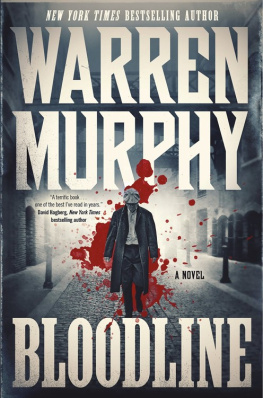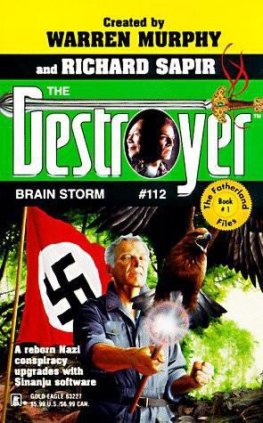Warren Murphy - The Last Dragon
Here you can read online Warren Murphy - The Last Dragon full text of the book (entire story) in english for free. Download pdf and epub, get meaning, cover and reviews about this ebook. genre: Science fiction. Description of the work, (preface) as well as reviews are available. Best literature library LitArk.com created for fans of good reading and offers a wide selection of genres:
Romance novel
Science fiction
Adventure
Detective
Science
History
Home and family
Prose
Art
Politics
Computer
Non-fiction
Religion
Business
Children
Humor
Choose a favorite category and find really read worthwhile books. Enjoy immersion in the world of imagination, feel the emotions of the characters or learn something new for yourself, make an fascinating discovery.

- Book:The Last Dragon
- Author:
- Genre:
- Rating:5 / 5
- Favourites:Add to favourites
- Your mark:
- 100
- 1
- 2
- 3
- 4
- 5
The Last Dragon: summary, description and annotation
We offer to read an annotation, description, summary or preface (depends on what the author of the book "The Last Dragon" wrote himself). If you haven't found the necessary information about the book — write in the comments, we will try to find it.
The Last Dragon — read online for free the complete book (whole text) full work
Below is the text of the book, divided by pages. System saving the place of the last page read, allows you to conveniently read the book "The Last Dragon" online for free, without having to search again every time where you left off. Put a bookmark, and you can go to the page where you finished reading at any time.
Font size:
Interval:
Bookmark:
Destroyer 92: The Last Dragon
By Warren Murphy and Richard Sapir
Prologue
On the first pass, they missed it.
The earthquake had opened up great red-brown holes in the green African veldt, and the imaging analysts thought it was one of those. But a sharp-eyed photo enhancement analyst named Narvel Buckle saw the black blotches and bands dappling the elongated Halloween-pumpkin orange shape.
"I think it's alive," he muttered to himself. He told no one.
On the second pass, twelve hours later, it had moved three meters. Alive. Definitely.
His curiosity roused. Narvel made another search for it on the third pass. He told the satellite console operator that there were signs of volcanic activity. The government of Gondwanaland, he explained, would pay well for topographic photos of an emerging natural disaster like a volcano.
"They'll throw it into the package with our quake shots and they can double their foreign aid request," he said.
That was all he needed to say. The operator signaled the low-orbit Gaiasat camera to suppress all vegetation and bring up the warm end of the spectrum.
Luck was with Narvel on that third pass. The black-and-orange thing happened to be looking up as the satellite snapped a clear photograph that captured the upward-looking eyes. It was looking directly at the sun, which reflected as twin pinpoints of hot light.
"I know what that dadgum thing is!" he breathed, nearly dropping his jeweler's loupe.
And since he worked for a commercial satellite company which specialized in selling natural disaster damage assessment images to foreign countries-whose reputation could be ruined if they dared to put the photos on the international market-Narvel Buckle slipped the entire set into his briefcase, and set about peddling them out of his Chevy Chase apartment.
The National Enquirer laughed at him; they printed photos just like it every week. This week's issue was headlined BAT BOY FOUND LIVING IN CAVE! The managing editor's eight-year-old son had posed for it, and the computer graphics people had added the pointy ears and filed-to-chisels teeth.
Did Narvel have any shots of Liz or Madonna sunbathing in the nude? Preferably together? Maybe even kissing? No? Call when you do. Toodles.
The Smithsonian Institute in Washington kept shunting him back and forth between departments. The paleontology department couldn't have been less interested if he had been trying to sell them osteoporosis insurance.
"Our interests are restricted to old bones and fossils," a voice that sounded as if it had belonged to one of the latter said.
"But this is the real thing!" Narvel explained. "You can render it to the bone or something. Like they do with tired old horses to get glue."
"Try Natural History. I shall see if I can connect you."
The attempt was a magnificent one. Thirty-seven different people lifted department phones, ranging from anthropology to zoology, and tried to talk all at once.
Narvel Buckle finally hung up and asked the switchboard to connect him directly. After he explained what the satellite photos had disclosed, the chairman--or whatever he was-of the Smithsonian natural history department inhaled through his nose with a sound like a tiny elephant exhaling through his trunk.
"Impossible," he added.
"I got the photos," Narvel retorted. "And they're only two thousand dollars for the set of three."
"As I said, it is impossible. No such beast could be roaming the heart of Africa."
"Why the hell not?"
"For there to be one, there must be many."
"I don't follow."
"Follow this simple equation: One creature necessitates two parents. Two parents requires four grandparents. A quartet of grandparents implies a large sustaining population. No such population has ever been discovered on the African landmass."
"Hey, we're talking Africa here! It's not exactly Vegas."
"Africa has been satisfactorily explored. And certainly by now, an orbiting satellite would have snapped portraits of specimens such as you describe."
"That's what I got! High-resolution satellite images. In color. Nine by twelves. Glossies. "
"Impossible. Sorry. Try the paleontology department. Let me connect you."
"I don't want to be-"
Narvel Buckle hung up just as the bone-dry voice of the head paleontologist was saying "Yes?"
No other museum seemed interested. Narvel thought he had a sale to the Harvard Museum of Comparative Zoology, but when they wanted the president of the Gaia Satellite Reconnaissance Company to personally vouch for the authenticity of the photos in question, Narvel had to admit that he was selling his photos under the table. The curator hung up without another word.
Then someone at the Royal Ontario Museum in Toronto told him to try the cryptozoologists.
"The what?"
"Try the International Colloquium of Cryptozoologists in Phoenix. This is exactly their sort of meat."
Narvel didn't know what a cryptozoologist was, but he called the number the Phoenix directory assistance gave him.
A woman answered. She had a pleasant voice that made him think of Michelle Pfeiffer, and as he told his story, he could hear her breathe into the receiver, at first in warm, measured intervals, and then with increasing excitement.
"We are very, very interested in your photographs," she told him.
"Five grand for the set of three," Narvel said instantly.
"Can you supply the longitude and latitude of the sighting?"
"That'll be $39.99 extra."
"Done."
"Deal."
"One question," Narvel asked.
"Yes."
"What the heck is a cryptozoologist?"
"Cryptozoology is the study of hidden animals," the blondish-sounding voice explained. "That's what crypto means: hidden. We are interested in creatures common zoologists dismiss as mythological, or which are mistakenly believed to be extinct."
"Oh. No wonder you want these photos."
Narvel faxed muddy photocopies of the photos that very day and patiently waited for a return call. It never came.
The check arrived the next day by UPS Express. Narvel waited until the check had cleared before fedexing the three high-resolution color photographs that the Smithsonian Institute had turned down, along with the exact longitude and latitude at which the satellite had snapped the shots. He never heard back from the International Colloquium of Cryptozoologists, and none of the photos ever appeared in print. But Narvel Buckle didn't care about that. He was thinking that he should have asked for ten grand. At least.
Chapter 1
Dr. Nancy Derringer was starting to have second thoughts.
The heart of equatorial Africa was no place for second thoughts, never mind fear. But Nancy, blond as corn silk, willowy as bamboo, and tough as Arizona sagebrush, was experiencing both.
Those who knew her well claimed she was as fearless as the crocodiles she had spent her short adult life studying.
As the chief paleontologist and herpetologist for the International Colloquium of Cryptozoologists, Nancy Derringer had trudged through Himalayan snows for Yeti, plumbed deep-water lakes all over the Americas and the British Isles for surviving plesiosaurs, and penetrated abyssal depths in quest of garagantuan cephalopods.
Africa was a different matter. It was a hothouse for tropical diseases like river blindness and monkey pox, the reputed incubator for AIDS. A Caucasian had to undergo two months of inoculations before embarking on an expedition into the continent's humid heart.
They injected her twice against cholera, twice against typhoid, subjected her to a precautionary rabies injection that they warned might do no good if she were bitten in the wild, gave her a tetanus booster shot, and then sugar lumps impregnated with polio vaccine to take orally.
Next pageFont size:
Interval:
Bookmark:
Similar books «The Last Dragon»
Look at similar books to The Last Dragon. We have selected literature similar in name and meaning in the hope of providing readers with more options to find new, interesting, not yet read works.
Discussion, reviews of the book The Last Dragon and just readers' own opinions. Leave your comments, write what you think about the work, its meaning or the main characters. Specify what exactly you liked and what you didn't like, and why you think so.



